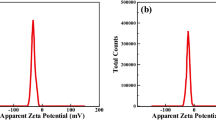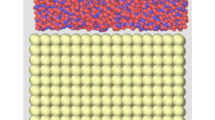Abstract
Heat conduction of nanoconfined liquid may differ from its bulk because of the effects of size, geometry, interface, temperature, etc. In this study, the roles of some critical factors for the heat conduction of nanoconfined water film are systematically analyzed by using the molecular dynamics method. With decreasing thickness, the normal thermal conductivity of nanoconfined water film between two copper plates decreases exponentially, while the thermal resistance, peak of the radial distribution function, and atomistic heat path increase exponentially. The average bond order, radial distribution function, mean squared displacement, and vibrational density of states are calculated to analyze the effects of structure, distribution, molecular diffusion, and vibration of water molecules on heat conduction especially in a region having no oxygen atoms (which is observed by the near-wall density profile). The results show that phonon scattering is dominant for determining the reduced thermal conductivity in this near-wall region. The thermal conductivity ratio of confined water film to bulk water has a roughly linear relationship with the logarithm of the proportion of the near-wall region. Moreover, the high interfacial thermal resistance is positively correlated to the film thickness, but it has a negligible impact on heat conduction. This work provides insights into the contribution of water molecules near the solid/liquid interface to the heat conduction of nanoconfined liquid for process intensification.
Similar content being viewed by others
References
Morshed A., Paul T.C., Khan J.A., Atomistic simulation of temperature dependent thermal transport across nanoconfined liquid. Physica E: Low-dimensional Systems and Nanostructures, 2013, 47: 246–251.
Liu Q.X., Jiang P.X., Xiang H., Molecular dynamics simulation of thermal conductivity of an argon liquid layer confined in nanospace. Molecular Simulation, 2010, 36(13): 1080–1085.
Lederle C., Sattig M., Vogel M., Effects of partial crystallization on the dynamics of water in mesoporous silica. The Journal of Physical Chemistry C, 2018, 122(27): 15427–15434.
Erko M., Findenegg G.H., Cade N., Michette A.G., Paris O., Confinement-induced structural changes of water studied by Raman scattering. Physical Review B, 2011, 84(10): 104205.
Naguib N., Ye H., Gogotsi Y., Yazicioglu A.G., Megaridis C.M., Yoshimura M., Observation of water confined in nanometer channels of closed carbon nanotubes. Nano Letters, 2004, 4(11): 2237–2243.
Gad-el-Hak M., The fluid mechanics of microdevices—the Freeman scholar lecture. 1999. DOI: https://doi.org/10.1115/1.2822013.
Tombari E., Ferrari C., Salvetti G., Johari G.P., Dynamic and apparent specific heats during transformation of water in partly filled nanopores during slow cooling to 110 K and heating. Thermochimica Acta, 2009, 492(1–2): 37–44.
Barati Farimani A., Aluru N.R., Spatial diffusion of water in carbon nanotubes: from fickian to ballistic motion. The Journal of Physical Chemistry B, 2011, 115(42): 12145–12149.
Titantah J.T., Karttunen M., Hydrophobicity: effect of density and order on water’s rotational slowing down. Soft Matter, 2015, 11(40): 7977–7985.
Hwang C.C., Hsieh J.Y., Chang K.H., Liao J.J., A study of rupture process of thin liquid films by a molecular dynamics simulation. Physica A: Statistical Mechanics and its Applications, 1998, 256(3–4): 333–341.
Xue L., Keblinski P., Phillpot S.R., Choi S.S., Eastman J.A., Effect of liquid layering at the liquid-solid interface on thermal transport. International Journal of Heat and Mass Transfer, 2004, 47(19–20): 4277–4284.
Liu Y., Wang Q., Zhang L., Dynamics and density profile of water in nanotubes as one-dimensional fluid. Langmuir, 2005, 21(25): 12025–12030.
Liu Y., Wang Q., Transport behavior of water confined in carbon nanotubes. Physical Review B, 2005, 72.8: 085420.
Thomas J.A., Iutzi R.M., McGaughey A.J.H., Thermal conductivity and phonon transport in empty and water-filled carbon nanotubes. Physical Review B, 2010, 81(4): 045413.
Zhao Z., Sun C., Zhou R., Thermal conductivity of confined-water in graphene nanochannels. International Journal of Heat and Mass Transfer, 2020, 152: 119502.
Shayeganfar F., Beheshtian J., Interfacial properties of water/heavy water layer encapsulate in bilayer graphene nanochannel and nanocapacitor. Journal of Materials Science: Materials in Electronics, 2019, 30(13): 11964–11975.
Chen J., Walther J.H., Koumoutsakos P., Strain engineering of Kapitza resistance in few-layer graphene. Nano Letters, 2014, 14: 819–825.
Hu S., Zhang Z., Jiang P., Chen J., Volz S., Nomura M., Li B., Randomness-induced phonon localization in graphene heat conduction. The Journal of Physical Chemistry Letters, 2018, 9: 3959–3968.
Rajabpour A., Volz S., Thermal boundary resistance from mode energy relaxation times: Case study of argon-like crystals by molecular dynamics. Journal of Applied Physics, 2010, 108: 094324.
Zhang Z., Xie Y., Peng Q., Chen Y., Geometry, stability and thermal transport of hydrogenated graphene nanoquilts. Solid State Communications, 2015, 213: 31–36.
Feldman J.L., Kluge M.D., Allen P.B., Wooten F., Thermal conductivity and localization in glasses: Numerical study of a model of amorphous silicon. Physical Review B, 1993, 48: 12589.
Tombari E., Salvetti G., Ferrari C., Johari G.P., Position-dependent energy of molecules in nano-confined water. Physical Chemistry Chemical Physics, 2005, 7(19): 3407–3411.
Frank M., Drikakis D., Solid-like heat transfer in confined liquids. Microfluidics and Nanofluidics, 2017, 21(9): 148.
Plimpton S., Fast parallel algorithms for short-range molecular dynamics. Journal of Computational Physics, 1995, 117(1): 1–19.
Stukowski A., Visualization and analysis of atomistic simulation data with OVITO — the Open Visualization Tool. Modelling and Simulation in Materials Science and Engineering, 2009, 18(1): 015012.
Lim M.C.G., Zhong Z.W., Molecular dynamics analyses of an Al(110) surface. Physica A: Statistical Mechanics and its Applications, 2009, 388(19): 4083–4090.
Hockney R.W., Eastwood J.W., Particle-Particle-Particle-Mesh (P3M) Algorithms. Computer Simulation Using Particles, 1988: 267–304.
In’t Veld P.J., Ismail A.E., Grest G.S., Application of Ewald summations to long-range dispersion forces. The Journal of chemical Physics, 2007, 127(14): 144711.
Evans D.J., Holian B.L., The Nose-Hoover thermostat. The Journal of Chemical Physics, 1985, 83(8): 4069–4074.
Jorgensen W.L., Chandrasekhar J., Madura J.D., Impey R.W., Klein M.L., Comparison of simple potential functions for simulating liquid water. The Journal of Chemical Physics, 1983, 79(2): 926–935.
Wirnsberger P., Frenkel D., Dellago C., An enhanced version of the heat exchange algorithm with excellent energy conservation properties. The Journal of Chemical Physics, 2015, 143(12): 124104.
Yaws C.L., Chemical properties handbook: physical, thermodynamic, environmental, transport, safety and health related properties for organic and inorganic chemicals, McGraw-Hill Education, 1999.
Matsubara H., Kikugawa G., Bessho T., Yamashita S., Ohara T., Effects of molecular structure on microscopic heat transport in chain polymer liquids. The Journal of Chemical Physics, 2015, 142(16): 164509.
Ohara T., Contribution of intermolecular energy transfer to heat conduction in a simple liquid. The Journal of Chemical Physics, 1999, 111(21): 9667–9672.
Martinez-Gonzalez J.A., English N.J., Gowen A.A., Structure and stretching dynamics of water molecules around an amphiphilic amide from FPMD simulations: A case study of N, N-dimethylformamide. Journal of Molecular Liquids, 2020, 302: 112524.
Gonzalez-Valle C.U., Ramos-Alvarado B., 17th IEEE Intersociety Conference on Thermal and Thermomechanical Phenomena in Electronic Systems (ITherm). IEEE, 2018: 86–91. DOI: https://doi.org/10.1109/ITHERM.2018.8419565
Abraham F.F., The interfacial density profile of a Lennard-Jones fluid in contact with a (100) Lennard-Jones wall and its relationship to idealized fluid/wall systems: A Monte Carlo simulation. The Journal of Chemical Physics, 1978, 68(8): 3713–3716.
Wang G.J., Hadjiconstantinou N.G., Molecular mechanics and structure of the fluid-solid interface in simple fluids. Physical Review Fluids, 2017, 2(9): 094201.
Steinhardt P., Nelson D., Ronchetti M., Bond-orientational order in liquids and glasses. Physical Review B, 1983, 28(2): 784.
Lechner W., Dellago C., Accurate determination of crystal structures based on averaged local bond order parameters. The Journal of chemical physics, 2008, 129(11): 114707.
Allen M.P., Tildesley D.J., Computer Simulation of Liquids, Oxford University Press, New York, 2017.
Kendall M., Stuart A., Ord J.K., Kendall’s Advanced Theory of Statistics, Oxford University Press, New York, 1987.
Zhang T., Xu B., Chen Z., Effect of graphite layers on the conformation and thermal conductivity of n-octadecane: A molecular dynamics study. Journal of Thermal Science, 2021, 30(5): 1789–1802.
Wang G.J., Hadjiconstantinou N.G., Layered fluid structure and anomalous diffusion under nanoconfinement. Langmuir, 2018, 34(23): 6976–6982.
Mittal J., Errington J.R., Truskett T.M., Relationships between self-diffusivity, packing fraction, and excess entropy in simple bulk and confined fluids. The Journal of Physical Chemistry B, 2007, 111(34): 10054–10063.
MacDonald J.R., Review of some experimental and analytical equations of state. Reviews of Modern Physics, 1969, 41(2): 316.
Elton D.C., Fernández-Serra M., The hydrogen-bond network of water supports propagating optical phonon-like modes. Nature Communications, 2016, 7(1): 1–8.
Shao C., Rong Q., Li N., Bao H., Understanding the mechanism of diffuse phonon scattering at disordered surfaces by atomistic wave-packet investigation. Physical Review B, 2018, 98(15): 155418.
Tas G., Maris H.J., Picosecond ultrasonic study of phonon reflection from solid-liquid interfaces. Physical Review B, 1997, 55(3): 1852.
Shibahara M., Takeuchi K., A molecular dynamics study on the effects of nanostructural clearances on thermal resistance at a Lennard-Jones liquid-solid interface. Journal of Thermal Science and Technology, 2011, 6(1): 9–20.
Barisik M., Beskok A., Boundary treatment effects on molecular dynamics simulations of interfacial thermal resistance. Journal of Computational Physics, 2012, 231(23): 7881–7892.
Ramos-Alvarado B., Kumar S., Peterson G.P., Solid-liquid thermal transport and its relationship with wettability and the interfacial liquid structure. The Journal of Physical Chemistry Letters, 2016, 7(17): 3497–3501.
Acknowledgements
The authors are grateful for the financial supports from the National Natural Science Foundation of China (No. 51876058).
Author information
Authors and Affiliations
Corresponding author
Rights and permissions
About this article
Cite this article
Jin, L., Zhou, L. & Du, X. A Molecular Analysis of Critical Factors for Interface and Size Effects on Heat Conduction in Nanoconfined Water Film. J. Therm. Sci. 31, 1155–1166 (2022). https://doi.org/10.1007/s11630-022-1600-2
Received:
Published:
Issue Date:
DOI: https://doi.org/10.1007/s11630-022-1600-2




